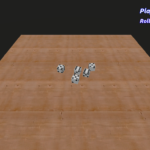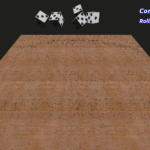Hopefully, the above pictures came through for you, or this wont make much sense. I’ve been working on my dice game, and it is nearly completed. However, as I test it out on different platforms, I notice that it doesn’t look the same. In the above screen shots, the left is from my Linux desktop, and the right is from my Android phone.
What hopefully is obvious is that the Android phone has an abnormal pixelation/black dots on it. Also notice that the table and dice are brighter on the Linux machine. Both screens are using a 1920×1080 resolution, so it isn’t a stretch/scale problem. The darkness of the Android screen is not a display brightness problem, as these are screen shots and not pictures of the screen. So what is causing this?
Well, after a bit of web searching, I came up with nothing. Thus, I must be using the wrong key words. But, after some trail and error, I found that the culprit was the texture normals for the table. Interesting. As far as I can tell, the normals are used to calculate light beams reflecting/refracting off of the surface of the object. For some odd reason, the normals texture overlay work great on the computer, but fail miserably on the phone. But both phone and computer support openGL 2 and 3, and this game is only openGL 2.
So, I don’t know why it happens. If you happen to know, please feel free to let me know in the comments. What I did to fix it was remove the normals texture overlay, and just use the textured wood overlay for the table. Now both the phone and the computer look the same. As always, you can check out the full project on my GitLab.
Linux – keep it simple.

